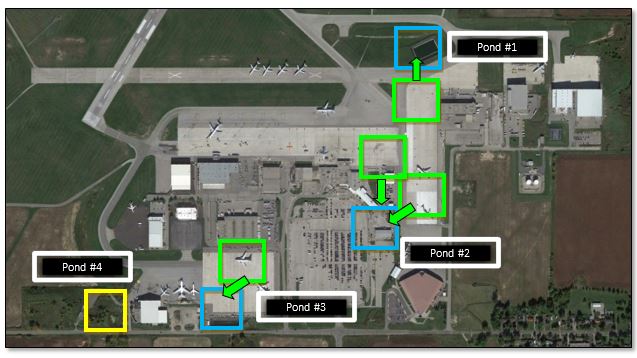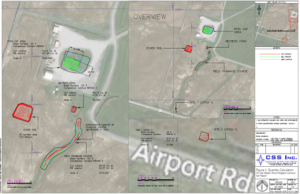Environmental Management
Monitoring and minimizing the environmental impact of airport operations is important to Hamilton International. The Airport’s Environmental Mission Statement is as follows:
Hamilton International Airport is committed to protecting the environment and safeguarding the health of its employees, business partners and the general public.
The aviation industry is highly regulated by both Transport Canada and the provincial Ministry of the Environment. Hamilton International works closely with both organizations to ensure responsible and thorough environmental management of the Airport to meet governmental standards.
Commitment to Emissions Reduction:
John. C Munro Hamilton International Airport, a wholly owned subsidiary of TradePort International Corporation and part of Vantage Group, is fully committed to reducing its impact on the environment. Utilizing best-in-class resources in environmental management and sustainability through Vantage, Hamilton International will look to achieve reductions in key resource usage performance indicators while improving other processes in a sustainable manner.
For more information on Hamilton International’s Commitment to Emissions Reduction, please click here.
Glycol Management:
Introduction
John C. Munro Hamilton International Airport has an Environmental Management Plan which includes the management of de-icing/anti-icing solutions applied to aircraft during the winter season. These solutions are sprayed on aircraft to remove or prevent accumulation of snow and/or ice and is essential for the safe operation of aircraft during the winter season. One of the main components of the Environmental Management Plan is the management and monitoring of glycol use. During this time period there may be correlating odours.
Glycol Types
There are 2 types of commonly used glycol products for de-icing operations, Propylene Glycol (PG) and Ethylene Glycol (EG). Both PG and EG products are biodegradable and do not bio-accumulate in the environment. Propylene glycol is commonly found in food, cosmetics and pharmaceutical products. Hamilton International is currently using Propylene Glycol which has a relatively low toxicity to mammals and breaks down in the natural environment quicker than Ethylene Glycol.
There are 2 variations of PG used in winter operations, Type I (de-ice) and Type IV (anti-ice).
Alternative methods such as brushing off snow are used to minimize the use of glycol products but is dependent on the weather conditions at the time.
Glycol Operations
During the winter months, de-icing fluid is applied to the exterior of an aircraft on designated de-icing pads (see Figure 1). Once the aircraft leaves this designated area a vacuum vehicle is dispatched and collects the excess glycol. These collected liquids are stored in holding tanks and the contents are removed offsite though a waste management contractor for recycling and re-use. Small amounts of low concentration residual glycol are collected through isolated catch basins which are directed to holding ponds/tanks. Depending on conditions, the residual glycol may also be absorbed into snow which is then pushed to designated snow piling areas. As this snow melts, this also drains into the holding ponds. Water samples from these ponds and the surrounding creeks are collected and tested regularly to monitor the concentration of glycol as per an agreement with the Ministry of the Environment and Climate Change.
Holding ponds at Hamilton International are monitored and tested on a regular basis and when admissible, water from the ponds is diverted to either the local sanitary system or creeks. However, before discharge occurs, the holding ponds may produce odours from biodegradation which is similar to that of a natural pond with decomposing organic material. Glycol operations are authorized on four (4) de-icing pads on the airfield (outlined in green below). There are currently three (3) active low concentration ponds/tanks (outlined in blue below) in operation and one (1) inactive pond (outlined in yellow below).

Figure 1: Location of de-icing pads and glycol storage areas
Glycol Management Partners
Hamilton International manages the dispensing and removal of glycol products and works in partnership with the City of Hamilton, the Ministry of the Environment and Climate Change (MOECC) and the Niagara Peninsula Conservation Authority (NPCA) to ensure proper environmental management. Hamilton International strives to be a good neighbour and has agreements in place with the above-mentioned organizations to ensure best practices are conducted for environmental compliance programs.
For a list of Frequently Asked Questions (FAQs), please click here.
For additional information, please contact odours@flyhamilton.ca.
PFOS:
PFOS and the Use of Firefighting Foam at Hamilton International:
PFOS Updates:
December 2011 – Hamilton International Airport, in consultation with the Ministry of the Environment (MOE) and City of Hamilton, has completed the initial subsurface investigation to confirm the presence and extent of perfluorooctane sulfonate (PFOS) contamination on airport property and identify remediation options. Hamilton International is committed to full, open disclosure of all matters pertaining to this issue. We are posting below our consultant’s findings and expert opinion on remedial options.
May 2018 – Since 2011, Hamilton International Airport has been working with various levels of government to understand and address impacts associated with historical activities conducted at the former fire-fighting training area located on the Airport property. The Airport has continued to work with various levels of government for the appropriate solution.
March 2018 – The MOECC (Ministry of Environment and Climate Change) affirmed that no PFOS-related parameters were detected in surface water samples at the property boundary above applicable regulatory guidelines. The MOECC also affirmed that recent groundwater samples collected from 24 monitoring wells located along the Airport property boundary exhibited no PFOS-related parameters above applicable regulatory guidelines. To support the ongoing efforts on this matter, the Airport retained a specialized environmental consultant who has in-depth expertise in the assessment of PFOS-related parameters. A plan has been developed to support ongoing monitoring and, if needed, additional remedial effort. The MOECC (Ministry of Environment and Climate Change) affirmed that no PFOS-related parameters were detected in surface water samples at the property boundary above applicable regulatory guidelines. The MOECC also affirmed that recent groundwater samples collected from 24 monitoring wells located along the Airport property boundary exhibited no PFOS-related parameters above applicable regulatory guidelines. To support the ongoing efforts on this matter, the Airport retained a specialized environmental consultant who has in-depth expertise in the assessment of PFOS-related parameters. A plan has been developed to support ongoing monitoring and, if needed, additional remedial effort.
September – October 2019 – Working in collaboration with the Ministry of Environment, Conservation and Parks (MECP), TradePort, the City of Hamilton and the John C. Munro Hamilton International Airport finalized a Preventive Measures Order (a “PMO”) to address environmental impacts associated with Transport Canada’s historical firefighting practices on the Airport lands.
The PMO was a critical milestone in our nearly decade-long and on-going effort to address legacy impacts from per- and polyfluoroalkyl substances (“PFAS”), which were used in firefighting foams. The PMO allowed TradePort and the Hamilton Airport to take actions to address impacted soil, sediment and surface water in the former firefighting training area, and to mitigate future off-site migration of PFAS associated with Transport Canada’s use of this area.
Working jointly with the Ministry, Hamilton International implemented a Mitigation Plan that included:
- the dewatering and restoration of an existing stormwater retention pond (completed September 18, 2019);
- excavation and long-term containment of PFAS-impacted soil and sediment (completed September 24, 2019 outlined on Diagram 1 below);
- installation of a low-permeability geosynthetic clay liner cap over the former fire-fighting training area (completed October 11, 2019); and
- the hydroseeding the FFTA cap, western pond and field drainage course to vegetate the surfaces and minimize erosion.
These mitigation measures were completed between September 16, 2019 and October 11, 2019. This collaborative process with the Ministry to address legacy impacts from Transport Canada’s historical use of the Airport lands demonstrates TradePort and the City of Hamilton’s ongoing commitment to public safety and the protection of the environment.
Diagram 1: Mitigation Plan Post Construction Survey

2020/2021 Update – Following implementation of the Mitigation Plan in the fall of 2019, Hamilton International has continued to conduct regular monthly inspections of the former firefighting training area to monitor and maintain the integrity of the cap and ensure a vegetative cover has established to mitigate against potential erosion.
The Airport continues to work with various levels of government in a collaborative and proactive manner to address impacts associated with historical activities at the Airport.
2022 Update – In collaboration with the Ministry of the Environment, Conservation and Parks (“MECP”), TradePort and Hamilton International Airport recently developed and implemented additional mitigation measures at the former firefighting training area which included:
- Dewatering and decommissioning of an existing stormwater retention pond at the former Fire-Fighting Training Area (FFTA);
- Installation of a low permeability soil cap over the decommissioned pond and perimeter ditches surrounding the former FFTA; and,
- Restoration (topsoil and seeding) of mitigated areas to vegetate the surfaces and minimize erosion.
These mitigation measures were completed between September 23, 2022, and October 5, 2022 to reduce the concentration of PFAS in surface water at Hamilton International while the Airport continues to maintain a water monitoring program. All measures conducted to date, demonstrate that Hamilton International is committed to public safety and the protection of the environment, while addressing the legacy impacts created by the use of PFOS-containing aviation firefighting foam for training between 1985 and 1989, when the Airport was federally owned and operated by the Region.
2023 Update – TradePort and Hamilton International continue to work in collaboration with the MECP, with the following completed during the year:
- Continuation and expansion of sampling program in effect, monitoring the works completed in 2023, including monthly inspections; and
- Repairs, maintenance, expansion and assessment of infrastructure in place to support the sampling programs.
For additional information, please contact environment@flyhamilton.ca.

